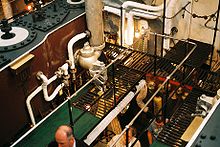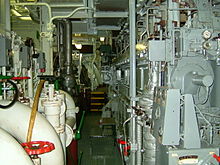On a ship, the engine room, or ER, is the propulsion machinery spaces of the vessel. To increase a vessel’s safety and chances of surviving damage, the machinery necessary for operations may be segregated into various spaces. The engine room is one of these spaces, and is generally the largest physical compartment of the machinery space. The engine room houses the vessel’s prime mover, usually some variations of a heat engine – diesel engine, gas or steam turbine. On some ships, the machinery space may comprise more than one engine room, such as forward and aft, or port or starboard engine rooms, or may be simply numbered.
On a large percentage of vessels, ships & boats, the engine room is located near the bottom and at the rear, or aft, end of the vessel, and usually comprises few compartments. This design maximizes the cargo carrying capacity of the vessel and situates the prime mover close to the propeller, minimizing equipment cost and problems posed from long shaft lines. The engine room on some ships may be situated mid-ship, especially on vessels built from 1900 to the 1960s. With the increased use of diesel electric propulsion packages, the engine room(s) may be located well forward, low or high on the vessel, depending on the vessel use.
Contents
Equipment
Engines
The engine room of a motor vessel typically contains several engines for different purposes. Main, or propulsion engines are used to turn the ship’s propeller and move the ship through the water. They typically burn diesel oil or heavy fuel oil, and may be able to switch between the two. There are many propulsion arrangements for motor vessels, some including multiple engines, propellers, and gearboxes.
Large engines drive electrical generators that provide power for the ship’s electrical systems. Large ships typically have three or more synchronized generators to ensure smooth operation. The combined output of a ship’s generators is well above the actual power requirement to accommodate maintenance or the loss of one generator.
On a steamship, power for both electricity and propulsion is provided by one or more large boilers giving rise to the alternate name boiler room. High pressure steam from the boiler is used to drive reciprocating engines or turbines for propulsion, and also turbo generators for electricity. Besides propulsion and auxiliary engines, a typical engine room contains many smaller engines, including generators, air compressors, feed pumps, and fuel pumps. Today, these machines are usually powered by small diesel engines or electric motors, but may also use low-pressure steam.
Engine cooling
The engine(s) get required cooling from liquid-to-liquid heat exchangers connected to fresh seawater or divertible to recirculate through tanks of seawater in the engine room. Both supplies draw heat from the engines via the coolant and oil lines. Heat exchangers are plumbed in so that oil is represented by a yellow mark on the flange of the pipes, and relies on paper type gaskets to seal the mating faces of the pipes. Sea water, or brine, is represented by a green mark on the flanges and internal coolant is represented by blue marks on the flanges.
Thrusters
In addition to this array of equipment is the ships thruster system, typically operated by electric motors controlled from the bridge. These thrusters are laterally mounted propellers that can suck or blow water from port to starboard (i.e. left to right) or vice versa. They are normally used only in maneuvering, e.g. docking operations, and are often banned in tight confines, e.g. drydocks.
Thrusters, like main propellers, are reversible by hydraulic operation. Small embedded hydraulic motors rotate the blades up to 180 degrees to reverse the direction of the thrust.
Safety
Fire precautions
Engine rooms are hot, noisy, sometimes dirty, and potentially dangerous. The presence of flammable fuel, high voltage (HV) electrical equipment and internal combustion engines (ICE) means that a serious fire hazard exists in the engine room, which is monitored continuously by the ship’s engineering staff and various monitoring systems.
Ventilation

If equipped with internal combustion or turbine engines, engine rooms employ some means of providing air for the operation of the engines and associated ventilation. If individuals are normally present in these rooms, additional ventilation should be available to keep engine room temperatures to acceptable limits. If personnel are not normally in the engine space, as in many pleasure boats, the ventilation need only be sufficient to supply the engines with intake air. This would require an unrestricted hull opening of the same size as the intake area of the engine itself, assuming the hull opening is in the engine room itself. Commonly, screens are placed over such openings and if this is done, airflow is reduced by approximately 50%, so the opening area is increased appropriately. The requirement for general ventilation and the requirement for sufficient combustion air are quite different. A typical arrangement might be to make the opening large enough to provide intake air plus 1000 Cubic Feet per Minute (CFM) for additional ventilation. Engines pull sufficient air into the engine room for their own operation. However, additional airflow for ventilation usually requires intake and exhaust blowers.
History
Engine rooms were separated from its associated fire room on fighting ships from the 1880s through the 1960s. If either experienced damage putting it out of action, the associated engine room could get steam from another fire room.




















There is no need to set your alarm on anymore — PaperTyper.net is a safe service with free tools for essay writing. Numerous satisfied customers use its ever-upgrading free features from different countries. Do you want to learn more about this service? Then it is high time to get acquainted with this platform in detail. ExpertWriting is a professional college essay writing service that helps students with all types of academic writing assignments. The company has a team of professional college essay writers who are experienced in different fields of academic writing. They offer a range of services such as essay writing, research paper writing, term paper writing, and coursework writing. The company also offers editing and proofreading services to help students improve their essays. Essay Writing
http://www.mapaelectrificaciones.com/wp/?p=388
How to Write a Perfect UC Essay for Every Prompt.pdf Class of 2026Massachusetts Institute of Technology admitted 1,337 students out of 30,976 applicants to the Class of 2026 for an acceptance rate of 3.94 percent. In its early round, MIT admitted 719 students out of 15,036 applications, yielding 4.78 percent. Click above to watch a video on MIT Supplemental Essays. While AP and IB classes allow you to take the end-of-course exams for college credit, MIT generally does not accept the credit from these tests. The school wants all of its incoming freshmen to start at MIT on equal footing. However, MIT does grant credit for specific AP tests on which you score a five. You can look at the list of credit policies at MIT for different AP exams and scores on the school’s website. Each department at MIT establishes its credit policies for AP and IB tests. For a list of the credit policies for IB exams, you can look at the list on the school’s website.
purchase cialis online cheap At Harris Farms, he was called Junior